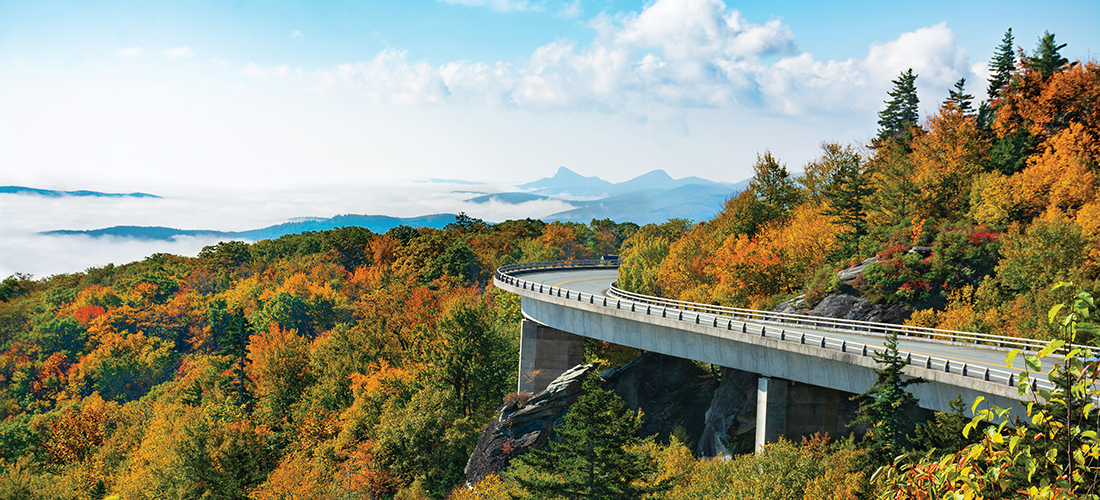
Traveling the Blue Ridge
A solemn stop on a road trip
By Tom Bryant
It was early fall, summer was gone and I was at loose ends. It always seems to happen to me during the change of seasons. It’s still too hot to do any serious fishing, hunting season is in — dove season, that is — but after the opening-day hunt there’s not much to do here in my neck of the woods. The local doves have moved on, and the migratory ones aren’t here yet. The same with ducks. With the mild weather, they’re still lounging around somewhere up north.
Linda, my bride, and I finished our last trip to the beach in the little Airstream. Nothing to do now but winterize and park it until February, when we head to Florida for winter fishing. But right now, like I said, I’m at loose ends.
Trying to write a little on my never-finished novel, I was up in the roost, what we call the small apartment over our garage, waiting on the muse to arrive. While plundering through some papers in an unused drawer of my desk, I ran across a brochure I’d saved about the Blue Ridge Parkway. It’s amazing how things come together, I thought. Next step, convincing Linda we needed a road trip.
The parkway has always been one of my favorite destinations, I guess because it’s beautiful and seems never-ending. It’s the longest linear national park in the country and runs 469 miles through Virginia and North Carolina. I’ve never driven from one end to the other, but someday I hope to.
Actually, there’s another reason for my interest in this monumental project constructed during the Great Depression. I closed out my newspaper career working for the descendants of Josephus Daniels, the early owner and publisher of The News & Observer in Raleigh. Without Josephus, the parkway probably would not have come through North Carolina at all.
My mind went back to early American history classes that I waded through while pursuing an education. If I remember correctly, back around 1917 during the World War I, the president of the United States, Woodrow Wilson, offered the job of secretary of the Navy to a loyal Democrat, Josephus Daniels, owner and publisher of The News & Observer, which was, at that time, the largest newspaper in the state of North Carolina. Daniels, in turn and needing help, offered the job of assistant to the secretary to another up-and-coming Democrat, Franklin Delano Roosevelt. Over time they became good friends.
When the idea of the parkway came up years later as a way to alleviate some of the unemployment during the Great Depression, Roosevelt was president. Tennessee was first in line to get the important revenue-producing project. Their idea was that the parkway was to run along the spine of the Great Smoky Mountains National Park. Naturally, the folks in the know in North Carolina wanted the parkway to run along the ridge of the Blue Ridge Mountains, and they had one great ally in Josephus Daniels, friend of the president. Josephus and his group of state promoters made several overtures to FDR, and he agreed to let the parkway come through Virginia and North Carolina. The Blue Ridge Parkway was born.
It’s ironic that I ended my newspaper career working for David Woronoff and Frank Daniels Jr., direct descendants of Josephus, the man who helped bring one of my favorite national parks to our state.
I explained to Linda that it was my duty to honor the legacy of my boss of several generations ago and visit the parkway. She laughed and said, “Any excuse for a road trip.” We planned to venture out the following week.
We were sitting around the kitchen table. “I say we head up to Virginia and hit the parkway there. We haven’t done any of the Virginia stretches yet,” I said. Linda had her atlas and I was scrolling through my iPad.
“How about the Peaks of Otter?” she said.
“The who of what?” I replied.
“The Peaks of Otter. I read somewhere that’s the Cherokee word for high places or maybe the area is just named after the nearby headwaters of the Otter River, whatever. It sounds beautiful.”
“And,” I replied showing Linda pictures on my iPad, “here is where we can stay, the Peaks of Otter Lodge.”
The following Monday found us on the road heading north, up through Greensboro on Highway 29. After an uneventful three-hour trip, we entered the picturesque little town of Bedford, Virginia, only about 20 miles from our destination right on the Blue Ridge Parkway.
The Peaks of Otter Lodge stretches out over 56 rooms with incredible views of Lake Abbott and the peaks beyond. There are several hiking trails geared to the expertise of the hiker, or you can do what I did most of the time we were not out exploring, and that’s kick back with a good book while relaxing in an Adirondack chair right next to the lake.
One thing on our must-do list was to visit the National D-Day Memorial in Bedford. The next morning we were up and at ’em early.
The memorial sits majestically right outside town at the base of the Blue Ridge and encompasses more than 50 acres. When we drove up to the entrance — a 44-foot-tall arch embellished by the code name “Overlord” — a feeling came over me, sort of like the one you get in church when a special hymn touches your heart. That day it did the same to us as we walked around the site. We were silent, hushed as if at a funeral.
These 50 acres in the small town of Bedford, Virginia, serve as a remembrance of over 2,500 young men and the dedication of a nation that owes everything to the heroes who would never see past that day, June 6, 1944, on the French shore.
Why Bedford? Given the population of the town, they lost the most. By the day’s end, 19 of their young men had died. I found the following quote in a brochure: “Recognizing Bedford as emblematic of all communities, large and small, whose citizen-soldiers served on D-Day, Congress warranted the establishment of the National D-Day Memorial here.”
That war, the second war to end all wars, is long gone. Without movies like Saving Private Ryan, there would likely be folks who don’t know what D-Day means or what happened or the sacrifices that took place on that amazing day. It seems that every generation has its own particular war. For me, it was Vietnam, for others the Gulf War, and others, Afghanistan. The list grows, seemingly interminable.
But looking back, I think about those true citizen-soldiers who fought in World War II: my dad in the Navy, my uncle Tommy in the Marines, and my uncle Hubert in the Army. They volunteered, knowing that they were in for the duration and this was the only way to help save the greatest nation, and perhaps the world, for the generations to come. The boys who gave all on D-Day were part of that group. It was indeed, I believe, the Greatest Generation.
The drive back up the mountain was subdued. Neither of us wanted to break the spell the D-Day Memorial had on us, but when we got back to the lodge we decided to celebrate our last day at the Peaks with dinner and a bottle of wine at the lodge restaurant.
The next morning we drove south on the parkway heading to Boone, pulling over at every overlook. The views were remarkable. The morning sun reflected off the russet-colored leaves of hickory and oak trees down in the valley.
At one overlook, Linda said, “This is really the greatest country in the world. Just look at this remarkable view. And think of all the people who made the parkway happen.”
“Yep,” I replied. “We have a lot of folks to thank for that.”
We loaded up and headed on south to Boone for a visit with our son, Tommy. PS
Tom Bryant, a Southern Pines resident, is a lifelong outdoorsman and PineStraw’s Sporting Life columnist.





